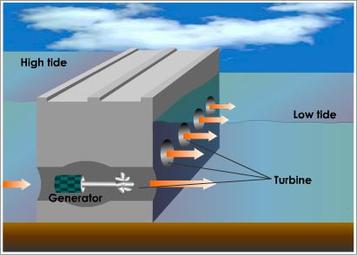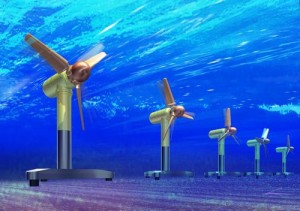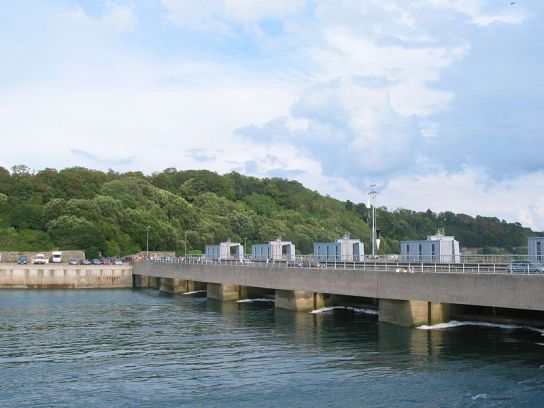COURTESY : greencleanguide.com
green tidal energy
Tidal energy, also known as tidal power is a renewable form of hydropower where the kinetic or potential energy of the tides are used for the generation of electricity. A tide is created by the gravitational effect of the sun and the moon on earth, thereby causing cyclical movement of the seas, leading to the tides. Because the earth’s tides are ultimately due to the gravitational forces between the sun, the moon and the earth, tidal energy is practically inexhaustible; thereby getting classified under renewable energy. Tidal power is the only technology that draws energy inherent in the orbital characteristics of the Earth-moon system, and to a lesser extent in the Earth-sun system.

It is a fairly new advancement in the area of renewable power generation, with the world’s first large tidal power plant being set up in the year 1966, under the name Rance Tidal Power station in France. Though not widely used now, it has a good potential for future electricity generation.
Historically, however, tidal mills have been used in Europe and America. Here, the water is captured in a pond or a catchment area and is allowed to strike a water wheel whose mechanical energy or power was used to mill grain.
is produced from the surge and fall of the ocean tides. It is used in areas where the difference between the rise and fall of the tides is large. Tidal power generation is still in its infancy, as there are only a few commercial scale power plants in the whole world. In fact only 20 sites in the world have been identified for possible tidal power stations. The Sihwa lake tidal power plant is the largest installation in the world with a capacity of 254MW. Investors are not enthusiastic on investing in tidal power as there is no guarantee of good profits or benefitting the costumers. Scientists and engineers are working on increasing the amount of electricity produced and also in making this form of energy more environment friendly and economically viable.
Generating methods
 Tidal stream generatorTidal stream generator (TSG): TSGs make use of the kinetic energy of the moving tides to rotate the turbines, in a similar way to wind turbines. Some tidal generators can be directly built into an existing bridge. They were first conceived in the 1970s during the oil crisis.
Tidal stream generatorTidal stream generator (TSG): TSGs make use of the kinetic energy of the moving tides to rotate the turbines, in a similar way to wind turbines. Some tidal generators can be directly built into an existing bridge. They were first conceived in the 1970s during the oil crisis.- Tidal barrage: Tidal barrages make use of potential energy: that is the difference in height between the high and the low of the tides. This energy can be seized with the placement of specialized dams on the course of flow. They are dam like structures that capture the energy of water moving in and out of a bay. They first allow the water to move in during high tide and release the water back during low tide. This is the key difference between a tidal barrage and a conventional dam. They are among the oldest methods of tidal power generation, with the Rance tidal power plant in France using the same method.
- Dynamic tidal power: Dynamic tidal power is an untried but promising technology or method that uses both the potential as well as kinetic energy of the tides.

Disadvantages of tidal energy
The tidal power generating apparatus may have harmful effects on marine life. The rotating blades of the turbine can kill the swimming aquatic life forms. Some species of fish may no longer inhabitate the area if threatened by a constant moving or noise making apparatus or source. Mechanical fluids such as lubricants can easily leak out, especially because of its use underwater and hence threaten the marine life. And proper maintenance of this equipment under water may not be viable.
The salt water of the sea or ocean can easily corrode the blades of the turbine. Though stainless steel blades of high quality can be used, they will increase the already high cost of setting up of the system.
Tidal power plants are expensive to construct, therefore they lack cost competitiveness.
Some of the current and future tidal power plants
- The first tidal plant was set up in the year 1966 in France, with an installed capacity of 240 MW.
- The tidal plant on the Sihwa Lake in South Korea is the largest in the world with a capacity of 254 MW.
- The first tidal plant in the USA is the Annapolis Royal generating station with a capacity of 20 MW.
- The Indian state of Gujarat is to host South Asia’s first commercial-scale tidal power station called the Kalpasar project. The company Atlantis Resources is now pursuing a 250MW project in the Gulf of Kutch. Since 2009 the company has been working with GPCL to complete the design and further construction of the project.
- In New York City, 30 tidal turbines will be installed by Verdant Power in the East River by 2015 with a capacity of 1.05MW.
- A £12bn scheme to develop a series of tidal power plants on the Swansea bay, with another four larger lagoons with a capacity of 7300 MW which is enough to meet 10% of UK’s energy needs by 2023.




